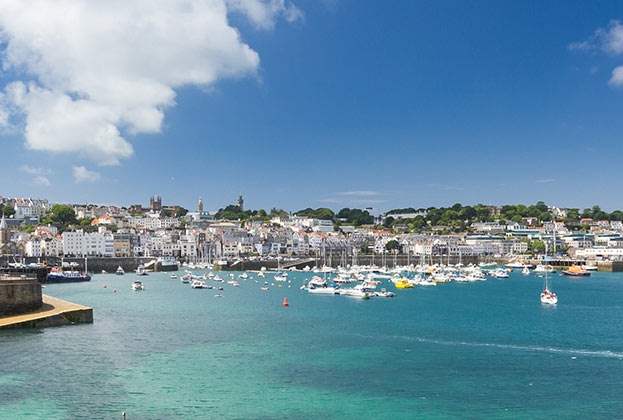Jersey saw continued growth in 2018, while transaction levels in Guernsey reached their highest levels since 2011
The Channel Islands offer residents an exceptionally high quality of life in a business-friendly environment. Safe and secure with excellent schools, recreation, restaurants, and a combined 72 miles of coastline in the two main islands, they are ideal locations to call home.
Host to businesses with international reach, they offer high-value employment, and a favourable environment to build a business. Their compact size also means short commutes, contributing to a favourable work-life balance.
.png)
Jersey and Guernsey have restrictions in place on who can purchase and occupy residential property. In Jersey, those who are not locally born may qualify under the High Value Residency (HVR) system, which requires a minimum annual tax contribution of £145,000. A small number of ‘unqualified’ properties are also available, that do not require HVR status. In addition, Jersey has a system in place for non-locals deemed essentially employed.
In Guernsey, 1,600 properties, or 6% of the island’s housing stock, are classed as ‘Open Market’ and available for any UK or EU national to buy (or other nationals via a special Entrepreneur or Investor visa). The rest, designated as ‘Local Market’, are for those born locally, or with an employment licence.
Jersey

A growing economy, low mortgage interest rates, and a shortage of stock have pushed Jersey’s mainstream residential markets to new highs. Demand for both owner occupiers and local buy to let investors has resulted in a shortage of supply priced under £500,000, and transactions in this price segment fell by 17% in 2018 as a result.
Meanwhile, domestic home movers have fuelled activity among property priced between £500,000 to £1m (+31% in transactions in 2018) and the £1m to <£2m bracket (+47% in transactions).
Sustained demand in Jersey continues to push up prices, which rose by 3.5% in 2018
Savills Research
Sustained demand continues to push up prices, which rose by 3.5% in 2018. The mix-adjusted average price reached £491,000, 14% above their former 2008 peak.
For property priced over £3m, the market has slowed, the result of high levels of prime stock and, in some cases, unrealistic vendor expectations. The impact of ongoing Brexit uncertainty has led to increased numbers of enquiries, but some prospective purchasers originating from the UK have been adopting a ‘wait and see’ approach as political uncertainty plays out. Nonetheless, sales in excess of £15m have already been seen in 2019.
One beneficiary has been the prime rental markets, which many new arrivals have turned to as they establish themselves on the island. The mainstream rental markets are buoyant too, this is, in part, due to affordability constraints in the sales markets, coupled with demand from people moving to the island for work. Advertised private sector rents increased by 9% in 2018.
.png)
Jersey residential transactions by price band
Source: Savills Research using Royal Courts of Jersey data
Guernsey
Guernsey’s mainstream residential market has returned to growth. Local Market residential transaction numbers reached their highest levels since 2011, while the Open Market hit an 11-year high. Taken together, market activity is now 14% above the 10-year average (but still 26% below 2007 levels).
Local Market residential transaction numbers in Guernsey reached their highest levels since 2011
Savills Research
Local Market prices in Guernsey reached a trough in the first quarter of 2018, following three years of price falls. But with transactions levels now rising, prices rose consecutively for the last three quarters of 2018, bringing annual price growth to 4%, with an average Local Market house price of £438,000.
Open Market activity has been driven by improved sentiment and more realistic pricing from vendors. A tax cap for new Open Market buyers came into effect in 2018, acting as another incentive. Some 75 Open Market transactions were recorded in 2018, levels not seen since 2007 when 96 Open Market sales were recorded. Like Jersey, political uncertainty in the UK has led to increased enquiries, rather than many more movers.
.png)
Guernsey residential transactions, Local and Open Market
Source: Savills Research using Unusualities of Guernsey
Political clarity in the UK, when it emerges, may unlock some pent-up demand in the islands’ prime residential markets
Savills Research
.png)
Residential price comparison: Jersey, Guernsey, London and UK mainstream markets
Source: Savills Research using States of Guernsey, States of Jersey and UK Land Registry | Note: *Four quarter rolling average
Residential market outlook
- ‘Pull factors’, such as high quality of life and favourable business environment, rather than ‘push factors’, such as Brexit, attract most individuals to the Channel Islands. However, we expect clarity on the political situation in the UK, when it emerges, to unlock some pent-up demand in the Guernsey and Jersey prime residential markets.
- Demand for prime property in both islands depends on their ongoing appeal to high net worth individuals as a place to live and build a business. Government is proactive in this respect, new business and individual movers are supported by government-funded organisations Locate Jersey and Locate Guernsey, who also promote the islands’ offer.
- Guernsey’s population is forecast to increase by just 3% to a maximum of 64,000 people by 2034. In Jersey, if the current rate of in-migration is sustained, its population is forecast to reach 128,000 in 2035, an increase of 21%. This, combined with a shortfall of new homes (estimated at 2,750 dwellings over the next three years alone) will support growth in Jersey’s residential markets. We expect prices in Guernsey to continue to recover as transactions return to longer-term trend levels.
Read the other articles within this publication below
.jpg)
.jpg)
